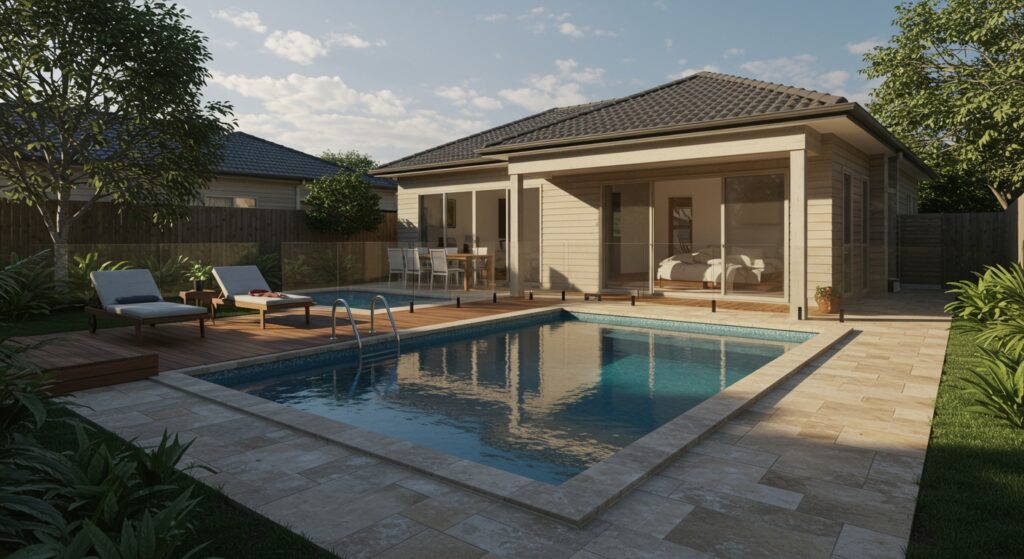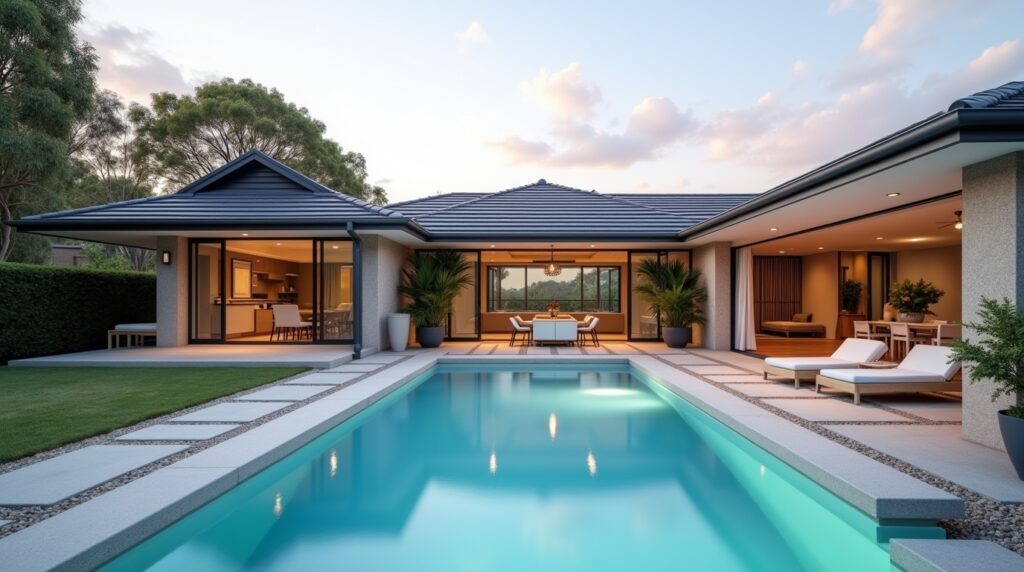In Melbourne, two identical pool projects can result in very different costs depending on whether they’re built in an inner suburb like Carlton or in outer areas such as Rowville or Werribee. While the pool design may be the same, the local context dramatically influences the final price.
This page breaks down the key reasons behind these cost differences — including regulatory requirements, site logistics, land conditions, and even stylistic expectations shaped by the neighbourhood. By understanding these factors, homeowners can better anticipate critical budget items and plan a pool project that fits both their property and their location — especially when comparing with overall costs across Melbourne suburbs
What Makes “Inner Suburb” Builds More Expensive
Building a pool in Melbourne’s inner suburbs typically costs more due to a combination of site limitations, planning requirements, and higher design expectations.
Narrow access and crane logistics
Inner suburbs like Carlton or Fitzroy often have limited side or rear access, making it difficult to bring in machinery or materials. In many cases, cranes must be used to lift components over buildings, adding significant cost to the project.
Permit complexity in councils like Yarra or Boroondara
Councils in inner Melbourne impose strict planning controls, particularly where heritage overlays or sensitive neighbourhood character areas apply. This adds complexity, time, and cost to the approval process.
Engineering for sloped, compact or heritage-aligned blocks
Inner suburb blocks often combine slope, tight boundaries, and historic building alignments. These factors demand custom engineering solutions to ensure stability and compliance, driving up the budget.
Higher aesthetic standards and material expectations
Pools in inner-city areas are frequently designed to complement high-end architectural homes, with premium finishes, custom features, and integrated landscaping. These stylistic expectations naturally increase overall costs.
Why Outer Suburbs Can Offer Cost Savings
Building a pool in Melbourne’s outer suburbs generally comes with fewer logistical and regulatory challenges, creating opportunities for meaningful cost savings.

Easier access and open space for worksites
Properties in areas like Rowville or Werribee typically offer wide side access and generous block sizes. This allows for straightforward machinery use and material delivery, reducing the need for cranes or specialised logistics.
Less regulation and simplified approvals
Outer suburban councils often have more streamlined planning processes with fewer overlays or heritage constraints. As a result, approval timelines are shorter and involve less expenditure on detailed documentation and consultant reports.
Less expensive landscaping and fencing expectations
In outer suburbs, pool designs often prioritise practicality over high-end architectural integration. Homeowners may choose simpler fencing, decking, and planting schemes, which can lower the overall cost compared to the more elaborate outdoor designs common in inner-city builds.
Which Pool Types Are More Common (and Affordable) by Zone?
In Melbourne’s inner suburbs, plunge pools, lap pools, and custom concrete designs dominate due to the need for precise site fitting and architectural alignment. These pool types are well-suited to compact, sloped, or heritage-sensitive sites, though they tend to come with higher price tags.
In outer suburbs, standard fibreglass pools are far more common thanks to their affordability, ease of installation, and compatibility with larger, flatter lots. These models provide excellent value for families seeking a functional pool without the complexity or cost of custom construction.
Hidden Costs That Appear Only in Some Suburbs
Certain pool costs in Melbourne emerge only once the site and approvals process are fully assessed. These hidden factors can significantly increase the budget, particularly in inner suburbs.
Utility relocations and easement negotiations
Inner-city properties often have older or complex utility networks. Pools may require the relocation of pipes or cables, or negotiation with authorities like Melbourne Water regarding easement use — adding unplanned engineering and administrative costs. For official guidance, see Melbourne Water Easement and Planning Info.
Arborist reports and heritage façade constraints
Projects in leafy, heritage-listed suburbs may trigger the need for arborist reports to protect significant trees, or design adjustments to preserve heritage façades. These requirements often mean additional consultant fees and extended approval timelines.
Noise and privacy compliance in dense zones
Pools in dense inner suburbs must often meet strict noise and privacy standards. Acoustic treatments, higher fencing, or screening solutions can increase both design complexity and build cost.
Comparing Price Ranges Across Typical Melbourne Zones
When comparing pool costs across Melbourne, the location often determines the budget more than the pool type itself.
Inner-north (Fitzroy, Carlton): Custom concrete pools typically start higher due to access, permits, and engineering — with price ranges often exceeding $90,000–$150,000.
Inner-east (Hawthorn, Camberwell): Similar premium pricing applies, especially for pools integrated into landscaped gardens, often $80,000–$140,000 — reflecting trends discussed in Brighton, Camberwell and Malvern

In Melbourne, the cost of building a pool depends first on your suburb, long before design or format choices come into play. From inner-city complexities to outer-suburb efficiencies, understanding the logic of your location helps anticipate critical budget items and select the right builder for your context.
Whether facing heritage restrictions in Carlton or enjoying easier access in Werribee, local conditions shape both process and price. For guidance on easements or approvals that might impact your project, see Melbourne Water Easement and Planning Info (lien #1 : “Melbourne Water Easement and Planning Info”).
